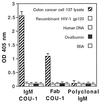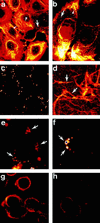Modified cytokeratins expressed on the surface of carcinoma cells undergo endocytosis upon binding of human monoclonal antibody and its recombinant Fab fragment
- PMID: 9223323
- PMCID: PMC21565
- DOI: 10.1073/pnas.94.15.8110
Modified cytokeratins expressed on the surface of carcinoma cells undergo endocytosis upon binding of human monoclonal antibody and its recombinant Fab fragment
Abstract
Previously, we have reported on successful imaging of colon, rectal, and pancreatic carcinomas in patients by using a radiolabeled all-human monoclonal antibody, COU-1, directed against modified cytokeratin. To further develop this antibody for use as an immunoconjugate, COU-1 was cloned by phage display selection and the human Fab fragment was expressed in bacteria. Analysis by confocal laser scanning microscopy demonstrated that COU-1 bound in a uniform punctate pattern to the surface of viable carcinoma cells stained at 4 degrees C, and binding increased significantly when cells were cultured on fibronectin, laminin, or collagen IV. In the case of fibronectin, COU-1 staining was particularly enhanced at intercellular junctions. When carcinoma cells were cultured with COU-1 at 37 degrees C for 6 hr, the antibody was found in large perinuclear vesicles and the punctate surface staining was significantly reduced. Similar results were obtained using intact IgM COU-1 and the recombinant Fab fragment. Immunohistological studies indicated that COU-1, in contrast to murine monoclonal antibodies against normal cytokeratin 8 and 18, could differentiate between malignant and normal colon epithelia, and between colon cancer metastasis in the liver and surrounding normal hepatocytes. Within biopsies of malignant tissue, COU-1 exhibited membrane-associated staining of proliferating cells, while resting cells had a filamentous pattern. Thus, modified cytokeratin at the surface of carcinoma cells may represent a new target for immunoconjugates and may explain the promising results of the phase I/II clinical study.
Figures




Similar articles
-
Cancer-associated cleavage of cytokeratin 8/18 heterotypic complexes exposes a neoepitope in human adenocarcinomas.J Biol Chem. 2002 Jun 14;277(24):21712-22. doi: 10.1074/jbc.M202140200. Epub 2002 Mar 28. J Biol Chem. 2002. PMID: 11923318
-
Phage display cloning and characterization of monoclonal antibody genes and recombinant Fab fragment against the CD98 oncoprotein.Jpn J Cancer Res. 2001 Dec;92(12):1313-21. doi: 10.1111/j.1349-7006.2001.tb02155.x. Jpn J Cancer Res. 2001. PMID: 11749697 Free PMC article.
-
Characterization of a recombinant humanized anti-cocaine monoclonal antibody and its Fab fragment.Hum Vaccin Immunother. 2015;11(2):458-67. doi: 10.4161/21645515.2014.990856. Hum Vaccin Immunother. 2015. PMID: 25692880 Free PMC article.
-
Construction and characterization of a Fab recombinant protein for Japanese encephalitis virus neutralization.Vaccine. 2004 Nov 25;23(2):163-71. doi: 10.1016/j.vaccine.2004.05.016. Vaccine. 2004. PMID: 15531033
-
The crystal structures of complexes formed between lysozyme and antibody fragments.EXS. 1996;75:301-19. doi: 10.1007/978-3-0348-9225-4_16. EXS. 1996. PMID: 8765306 Review.
Cited by
-
Surface keratin 1, a tumor-selective peptide target in human triple-negative breast cancer.Sci Rep. 2025 Jul 1;15(1):21644. doi: 10.1038/s41598-025-05351-z. Sci Rep. 2025. PMID: 40595898 Free PMC article.
-
Protein fragment domains identified using 2D gel electrophoresis/MALDI-TOF.J Biomol Tech. 2006 Apr;17(2):145-56. J Biomol Tech. 2006. PMID: 16741242 Free PMC article.
-
Cytokeratin 8 ectoplasmic domain binds urokinase-type plasminogen activator to breast tumor cells and modulates their adhesion, growth and invasiveness.Mol Cancer. 2009 Oct 21;8:88. doi: 10.1186/1476-4598-8-88. Mol Cancer. 2009. PMID: 19845941 Free PMC article.
-
Externalized Keratin 8: A Target at the Interface of Microenvironment and Intracellular Signaling in Colorectal Cancer Cells.Cancers (Basel). 2018 Nov 16;10(11):452. doi: 10.3390/cancers10110452. Cancers (Basel). 2018. PMID: 30453567 Free PMC article.
-
Overexpression of cell surface cytokeratin 8 in multidrug-resistant MCF-7/MX cells enhances cell adhesion to the extracellular matrix.Neoplasia. 2008 Nov;10(11):1275-84. doi: 10.1593/neo.08810. Neoplasia. 2008. PMID: 18953437 Free PMC article.
References
-
- Borup-Christensen P, Erb K, Jensenius J C, Nielsen B, Svehag S-E. Int J Cancer. 1986;37:683–688. - PubMed
-
- Erb K, Borup-Christensen P, Ditzel H, Chemnitz J, Haas H, Jensenius J C. Hybridoma. 1992;11:121–134. - PubMed
-
- Ditzel H, Erb K, Borup-Christensen P, Nielsen B, Jensenius J C. Hum Antibodies Hybridomas. 1991;2:135–141. - PubMed
-
- Borup-Christensen P, Erb K, Ditzel H, Nielsen B, Larsen J K, Svehag S-E, Jensenius J C. AMPIS. 1996;98:674–684. - PubMed
-
- Ditzel H, Rasmussen J W, Erb K, Borup-Christennsen P, Titlestad I, Lassen E, Fenger C, Kronborg O, Jensenius J C. Cancer Res. 1993;53:5920–5928. - PubMed
MeSH terms
Substances
Associated data
- Actions
- Actions
LinkOut - more resources
Full Text Sources
Other Literature Sources
Research Materials

